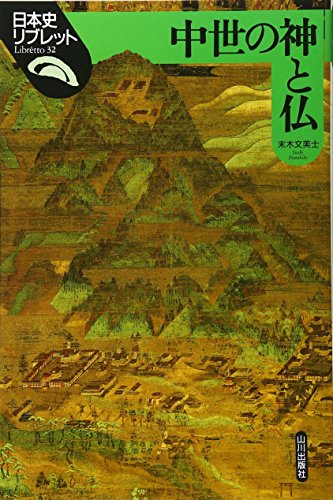15 0 0 0 OA 自殺考 : 南条あやのために
- 著者
- 末木 文美士
- 出版者
- 東京大学グローバルCOEプログラム「死生学の展開と組織化」
- 雑誌
- 死生学研究 (ISSN:18826024)
- 巻号頁・発行日
- vol.2, pp.35-55, 2003-11-25
6 0 0 0 OA 鎌倉仏教と現代 : 批判仏教の問題提起を受けて
- 著者
- 末木 文美士
- 出版者
- 駒澤大学
- 雑誌
- 駒澤大学佛教学部論集 (ISSN:0389990X)
- 巻号頁・発行日
- vol.30, pp.17-44, 1999-10
3 0 0 0 OA 哲学・神学から仏教へ
- 著者
- 末木 文美士
- 出版者
- 日本哲学会
- 雑誌
- 哲学 (ISSN:03873358)
- 巻号頁・発行日
- vol.2017, no.68, pp.81-97, 2017-04-01 (Released:2017-06-14)
- 参考文献数
- 18
After the theological turn in phenomenology, the relation between philosophy and theology has become very close. Jean-Luc Marion’s God without Being (1982) was the epoch-making work which showed the way from philosophy to theology.The subject of philosophy is not limited to manifest phenomena: the invisible is also important for our life and has to become the subject of philosophy. In this respect, it will be difficult to divide theology and philosophy.Turning to Buddhism, Imamura Hitoshi presented the idea of Buddhology in contrast to theology in Christianity. In my opinion, it will be possible to deal with the invisible in philosophy without this new field of Buddhology. Tanabe Hajime has already presented a ‘philosophy of death’, in which he discussed the existential cooperation of the living and the invisible dead. I would like to present a ‘philosophy of the manifest (ken) and the hidden (myō).’ The field of the hidden includes the dead, kami, Buddhas and other invisible aspects. Buddhism teaches the relation between the manifest and the hidden, but does not teach a transcendent God. Instead, Buddhist ideas of the dharma body, suchness and so on reveal the depth of the world of the manifest/ hidden, reminding us of the khôra of Plato and ‘place’ in Nishida Kitarō.
2 0 0 0 中世寺院の知的体系の研究-真福寺および勧修寺聖教の復治的研究
本研究の中心的対象である真福寺大須文庫の聖教典籍について、当初の方針にもとづき、基幹となる聖教を、全115合中50合まで調査を行い、カードに再訪し、そのうち40合まで、すなわち教相書の全てと事相書の前半部分にっいてデータ入力を終えた。そのうち20合までは報告書に略目録を収めた。調査の過程で発見した貴重な文献については、その一部を臨川書店『真福寺善本叢刊』第2期に影印翻刻と解題を付して、既に9巻を公刊している。本研究期間中には、『伝記験記集』『真福寺古目録集二』『法儀表白集』『伊勢神道集』『聖徳太子伝集』『中世先徳著作集』『性霊集注』の7巻が刊行された。本研究において真福寺の聖教典籍のうち、特に平安鎌倉期の諸宗の章疏や記録および神祇書については、二世信瑜を介した東大寺東南院伝来の文献群であることが明らかになり、中世真言教学興隆の中心的学僧であった頼瑜の著作群と併せて、真福寺の蔵書の価値が一層解明された。調査の一環として、未整理の大量の断簡について、平成16年度から予備調査を試み、その大半を閲覧し複数の分野で重要な文献を発見し、復原を試みた。その本格的な整理に、次年度からの科研費により着手を予定するが、これにより悉皆調査の基礎が築かれる。真福寺を軸として、中世寺院の経蔵が形成し蓄えた知的体系についての解明と歴史・宗教等諸学の研究との連携が進展し、その文献学一目録学的研究の重要性について学界共通の認識が醸成されつつある。特に説話文学会シンポジウム・ワークショップなどで文庫の保存の意義を社会に向けて発信した。なお関連する中世文学研究上の主題にっいて、本科研費の支援を得て毎年度公開研究集会を開催し、多大な成果を挙げた。勧修寺大経蔵聖教の調査については、入力されたデータの原本による確認を継続して遂行し全体の30%が完了している。
2 0 0 0 IR 自殺考 : 南条あやのために
- 著者
- 末木 文美士
- 出版者
- 東京大学グローバルCOEプログラム「死生学の展開と組織化」
- 雑誌
- 死生学研究 (ISSN:18826024)
- 巻号頁・発行日
- vol.2, pp.35-55, 2003-11-25
2 0 0 0 OA 古代インドの環境論
- 著者
- 原 實 川崎 信定 木村 清孝 デレアヌ フロリン ユベール デュルト 落合 俊典 岡田 真美子 今西 順吉 木村 清孝 末木 文美士 岡田 真美子 ユベール デュルト 田辺 和子 落合 俊典 デレアヌ フロリン 松村 淳子 今西 順吉 津田 眞一 北田 信 清水 洋平 金子 奈央
- 出版者
- (財)東洋文庫
- 雑誌
- 基盤研究(B)
- 巻号頁・発行日
- 2006
平成18年度より3年間、「古代インドの環境論」と題し、同学の士を誘って我々の専攻する学問が現代の緊急課題とどの様に関連するかの問題を、真剣に討究する機会を持ち得た事は極めて貴重な体験であった。外国人学者を交えて討論を重ねる間に、我々の問題意識はインド思想や佛教の自然観、地球観にまで拡がって行ったが、それらは現代の環境破壊や無原則な地域開発に警告する所、多大なるものがあった。「温故知新」と言われる所以である
1 0 0 0 OA 明治の仏教 -真言宗を中心として-
- 著者
- 末木 文美士
- 出版者
- 弘前大学人文社会科学部地域未来創生センター 深浦円覚寺古典籍保存調査プロジェクト
- 雑誌
- 深浦円覚寺所蔵古典籍調査調査報告 第三集
- 巻号頁・発行日
- pp.1-9, 2021-02-05
1 0 0 0 天台神道
- 著者
- 田村芳朗 末木文美士校注
- 出版者
- 神道大系編纂会
- 巻号頁・発行日
- 1990
1 0 0 0 OA 日本中世仏教の思惟方法の比較思想史的研究
- 著者
- 末木 文美士 阿部 泰郎 司馬 春英
- 出版者
- 国際日本文化研究センター
- 雑誌
- 基盤研究(C)
- 巻号頁・発行日
- 2012-04-01
本研究は、日本中世仏教の思惟方法を検討し、それを他の諸思想と比較し、現代的意味を探ることを目的とした。具体的には、(1)真福寺などに写本で伝えられる文献を調査し、その思想内容を分析した。(2)平成24年度には研究会を開催し、仏教研究者のみならず、現代哲学研究者も出席して、広い視野からの比較研究を進めた。(3)平成25年度には、中日仏学会議(北京)、世界哲学会議(アテネ)に出席して、成果を発表した。(4)比較研究を進めるために、Bernard Faureの著作Unmasking Buddhismを和訳するとともに、拙著『浄土思想論』の中国語訳、『仏教vs.倫理』の英訳を作成した。
- 著者
- 末木 文美士
- 出版者
- 昭和堂
- 雑誌
- 日本の哲学 (ISSN:1346051X)
- 巻号頁・発行日
- no.14, pp.94-109, 2013-12
1 0 0 0 OA 入宋僧の精神世界に関する文献学的および宗教学的研究
栄西や道元、円爾などの入宋僧の精神世界について、実地調査に基づきながら、文献学および宗教学の視点から再検討し、中世宗教研究の新たな展開を図かろうとした。具体的には、まず入宋僧たちが当時訪れたとされている現在中国の杭州や寧波、天台山、普陀山などの地域の寺院におけるそれぞれの足跡を実際に調査し、経済成長と宗教復興が進む近年において、それらの遺跡が一体どのような現状におかれているかを確認した。次はそれらに対する分析を踏まえつつ、歴史的、宗教的コンテキストに即して総合的な理解を試みようとした。さらには、仏教学や日本思想史などの諸分野による関連研究とも連携し、可能な限り学際的に検討することを目指した。
本研究は、H15年5月に開催された第48回ICES(国際東方学者会議、東方学会主催)におけるシンポジウム(「大乗仏教、その起源と実態-近年の論争と最新の研究成果から」)を皮切りに、総計10名の研究分担者がそれぞれの分担テーマに取り組み、これまでに12回の研究会、8回の講演会、印度学仏教学会等の国内学会、IAHR(国際宗教学宗教史学会)、ICANAS(国際アジア北アフリカ研究会議)、IABS(国際仏教学会)、ICES(国際東方学者会議)他の国際学会等を通して研究発表を重ね、'ここに研究成果をとりまとめるに至った。また、研究成果の一部は、H18年度の第51回ICESにおいて「大乗仏教、その虚像と実像-経典から論書へ」と題するシンポジウムにおいて公開した。本シンポジウムでの発表内容の一部は、H20年に刊行されるActa Asiatica,The Institute of Eastern Cultureの特集号(vol.96,"What is Mahayana Buddhism")に掲載予定である。本研究により、在家者による参拝という信仰形態をふまえ、新たなブッダ観・菩薩観のもとに経典運動として-既存の諸部派の中から-スタートした大乗仏教運動は、時期的には仏像の誕生とも呼応して、起源後から次第に影響力を増し、3世紀以降には最初期の経典をもとに多くの論書(大乗戒の思想を含む)を成立させるに至ったという大乗仏教の起源と実態に関する経緯の一端が明らかとなった。大乗仏教徒(mahayanika,mahayanayayin)とは、こうして成立した『般若経』『華厳経』『法華経』『阿弥陀経』等の大乗経典をも仏説として受け入れる出家、在家双方の支持者であり、これらの経典はいずれもそれぞれを支持するグループ(菩薩集団)独自のブッダ観あるいは菩薩観を、宗教文学にふさわしい物語性とともに、空や智慧、仏身論や菩薩の階梯などを論じる論書としての性格を帯びながら表明している。本研究では、これらの詳細を各研究分担者がそれぞれの専門を通して解明するという貴重な研究成果を得ることに成功した。本研究成果報告書は、いずれもこの研究期間内に研究代表者、研究分担者、および上記ICES,IAHRにおけるシンポジウムへの招聴研究者がもたらした研究成果の一端である。
1 0 0 0 OA 「観心略要集」の研究
- 著者
- 末木 文美士
- 出版者
- 東京大学東洋文化研究所
- 雑誌
- 東洋文化研究所紀要 (ISSN:05638089)
- 巻号頁・発行日
- vol.95, pp.179-294, 1984-11

